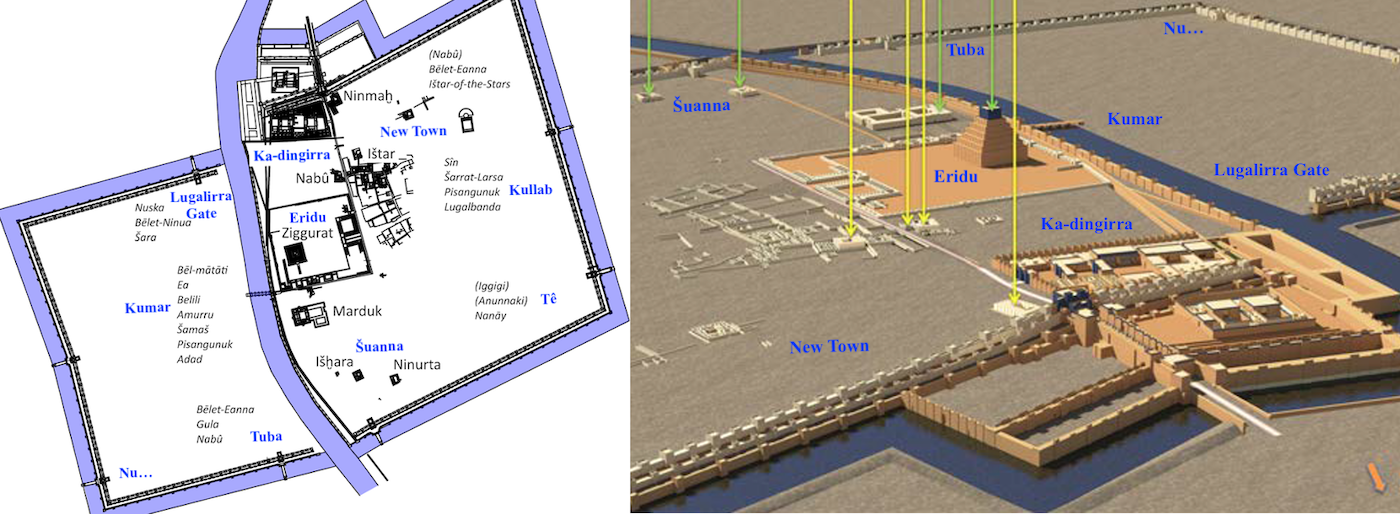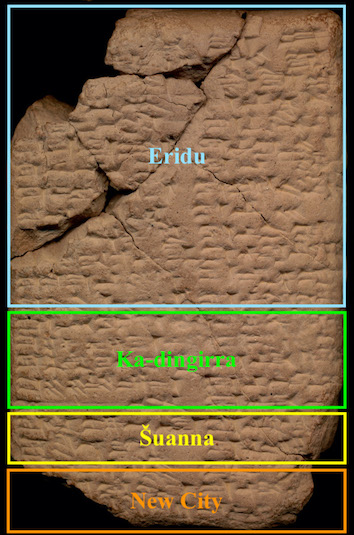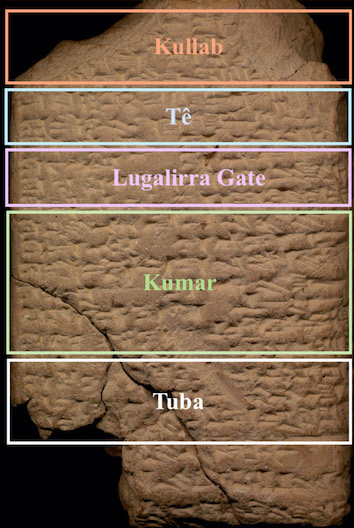Temples, Shrines, and Ziggurat of Babylon

The scholarly compendium Tintir = Babylon names forty-three temples, as well as forty-eight daises or pedestals, in the ten city quarters of the inner city of Babylon. Of those, only eight on the eastern side of the city have been excavated: Emah (the temple of the goddess Bēlet-ilī), Emašdari (the temple of Ištar of Agade), Ehilikalama (the temple of the goddess Ašratu), and Eniggidrukalammasuma (the temple of the god Nabû of the harû) in Ka-dingirra; Esagil (the temple of Babylon's patron deity Marduk) and Etemenanki (the ziggurat dedicated to Marduk) in Eridu; and Ehursagtila (the temple of the god Ninurta) and Ešasurra (the temple of the god Išhara) in Šuanna. The four northern temples, those in the Ka-dingirra district, have been reconstructed, while the southern temples, those in the Eridu and Šuanna districts, have not.

List of temples at Babylon by district (according to Tintir = Babylon Tablet IV)
Eridu (East Babylon)
- Ealtila: temple of the god Adad
- Egalmah (Ehursagsikila): temple of the goddess Gula
- Egišlaʾanki: temple of the god Nabû of Accounting
- Eguzalamah: temple of the god Ningišzida
- Ekarzagina: temple of the god Ea
- Enamtaggaduha: temple of the god Amurru
- Enitena: temple of the god Sîn
- Erabriri: temple of the god Madānu
- Esagdilannagidrutuku: temple of the god Papsukkal
- Esaggašara: temple of the goddess Anunītu
- Esagil: temple of the god Marduk
- Etemenanki: ziggurat of the god Marduk
- Eturkalama: temple of the goddess Bēlet-Bābili
- Ezidagišnugal: temple of the god Dumuzi of the captivity
Ka-dingirra (East Babylon)
- Emašdari: temple of the goddess Bēlet-Agade (Ištar)
- Ehilikalama: temple of the goddess Ašratu
- Emah: temple of the goddess Bēlet-ilī
- Eniggidrukalammasuma: temple of the god Nabû of the harû
Šuanna (East Babylon)
- Ehursagtila: temple of the god Ninurta
- Ešasurra: temple of the god Išhara
New City (East Babylon)
- Eandasaya: temple of the goddess Ištar of the Star
- Ekitušgirzal: temple of the goddess Bēlet-Eanna
- Eurunanam: dais of the god Nabû

Kullab (East Babylon)
- Ekišnugal (Egišnugal): temple of the god Sîn
- Emekiliburur: temple of the goddess Šarrat-Larsa
- Esag: temple of the god Lugalbanda
- Eurguba: temple of the deity Pisangunuk
Tê (East Babylon)
- Edurkuga: dais of the Igīgū gods
- Ekagula: dais of the Anunnakū gods
- Emeurur: temple of the goddess Nanāya
Lugalirra Gate (West Babylon)
- Ebursasa: temple of the god Šara
- Egišhurankia: temple of the goddess Bēlet-Ninūa
- Enunmah: temple of the god Nusku
Kumar (West Babylon)
- Edikukalama: temple of the god Šamaš
- Eʾesirkalama: temple of the deity Pisangunuk
- Eešmah: temple of the god Ea
- Ekadima: temple of the deity Belili
- Emesikila: temple of the god Amurru
- Enamtila: temple of the god Bēl-mātāti
- Enamhe: temple of the god Adad
Tuba (West Babylon)
- Ekitušgarza: temple of the goddess Bēlet-Eanna
- Esabad: temple of the goddess Gula
- Ešiddukišara: temple of the god Nabû
In addition to these forty-three temples, Babylon is known to have had other religious structures. The most important of these was Marduk's New Year's temple (Akkadian bīt akīti) Esiskur, which was outside and to the north of the inner city. Because it was not located in one of the city's ten districts, Esiskur was excluded from Tintir = Babylon Tablet IV.
Banner image: plan and reconstruction of Babylon with the excavated and unexcavated temples shown according to their city districts according to Tintir = Babylon Tablet IV [/btmao/Q000305]. Adapted from O. Pedersén, Babylon: The Great City, fig. 4.2 [https://uppsala.app.box.com/s/cgm386mr39f0we39y8v49ktecc664k0k/file/722114699771].
Jamie Novotny
Jamie Novotny, 'Temples, Shrines, and Ziggurat of Babylon', Babylonian Temples and Monumental Architecture online (BTMAo), The BTMAo Project, a sub-project of MOCCI, [http://oracc.org/btmao/Babylon/TemplesandZiggurat/]